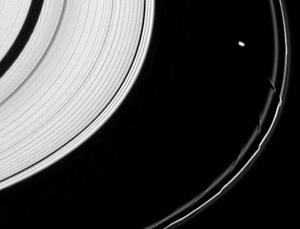Flaring lights of Saturn F ring
One of Saturn’s rings is flaring and fading in a very strange fashion. When Voyager 1 visited the planet in 1980, the ring was faint, but it sparkled with bright spots. By the time the Cassini mission arrived in 2004, the spots were gone – but the ring as a whole had grown twice as bright.
The F ring has been a puzzle since it was discovered by the Pioneer 11 spacecraft in 1979. While most of the inner rings have clear, well-defined edges, the F ring, which is the outermost of Saturn’s main rings, has a thin central core surrounded by a diffuse skirt of smoke-sized ice particles. That swirl of smoke forms kinks and knots, and some of it winds around the ring’s core in a spiral.
Most of these funny features can be blamed on the little moon Prometheus, which orbits just inside the F ring. As its elliptical orbit brings Prometheus towards and away from the ring on a 17-year cycle, the moon contorts the ring with its gravity. It even steals material from the ring when it comes too close, as its mythical namesake stole fire from the gods.
“We knew the F ring changed on a day to day and even hour to hour basis because of interactions with Prometheus,” says Robert French, a research assistant at the SETI Institute in Mountain View, California. “But people always assumed it was stable over the longer term, over decades if not millennia.”
So French and colleagues got a surprise when they compared images from the Voyager 1 and 2 missions, which zipped past Saturn in 1980 and 1981, with images from the Cassini spacecraft, which has been orbiting the planet since July 2004.
They found that the ring was twice as bright in 2004 as it was in 1980. It had also grown three times as wide and twice as opaque.
“All of that means there’s a lot more dust today than there used to be,” French says. Those tiny particles scatter sunlight, so when there are more of them the whole ring shines more brightly.
French’s first thought was to blame Prometheus. But while Prometheus’s orbit brought it closer to the F ring over the first 5 years of Cassini’s stay in the Saturn system, the ring didn’t change.
“That’s very puzzling,” French says. “People usually think of Prometheus as the cause of changes in the F ring, and Prometheus was making large changes in how it interacted with the F ring. Yet the F ring wasn’t changing.”
Weirder still, the ring got dimmer between Voyager 1′s departure and Voyager 2′s arrival – a period of just 9 months.
The images held one more mystery: the rings as Voyager 1 and 2 saw them were peppered with bright spots that glowed for a short time before fading. The Hubble Space Telescope saw similar spots in 1995. But by 2004, they had mostly disappeared.
All those oddities seemed to exonerate Prometheus as a cause of the light show. But in December 2006, one extremely bright spot exploded into view in the F ring. It raised the ring’s average brightness by 84 per cent and took more than two years to completely fade. Further examination showed that it flared up when a moonlet called S/2004S6 smacked into the ring’s core and burst apart in a puff of glitter.
If this bright spot could be caused by a bursting moonlet, could the others have a similar origin?
French’s team now propose a solution to explain the F ring oddities. When Prometheus gets very close, its gravity makes the ring’s ice particles move around faster. That breaks up clumps in the ring, making it shine more brightly. It should be brightest just after Prometheus’s closest approach, before the extra energy in the ice particles has a chance to dissipate.
But as Prometheus backs off, the ring calms down. Slowly, particles begin to cluster together again, making giant snowballs that grow under their own gravity. Prometheus helps pull some of these new moonlets off the edge of the ring.
After a while, they crash back into the ring’s core and explode into a sparkly cloud.
That’s what Voyager 1 and 2 saw as bright spots, French says. But eventually the ammunition runs out. “By 1985 or so, we were out of moonlets,” he says.
The process started again after Prometheus’s next close encounter with the ring in 1990, producing the bright spots Hubble saw in 1995. When Cassini arrived, Prometheus was getting closer to the ring, stirring up the icy smoke and making the overall ring as bright as we see it today. But there weren’t any moonlets left to make bright spots.
The idea is just a suggestion for now, but Cassini will get a chance to see if it’s true. By the end of Cassini’s extended mission in 2017, Prometheus will be in the same position as it was during Voyager, and French hopes to see the same thing happening. “If not, then we need to go back to the drawing board,” says French.

